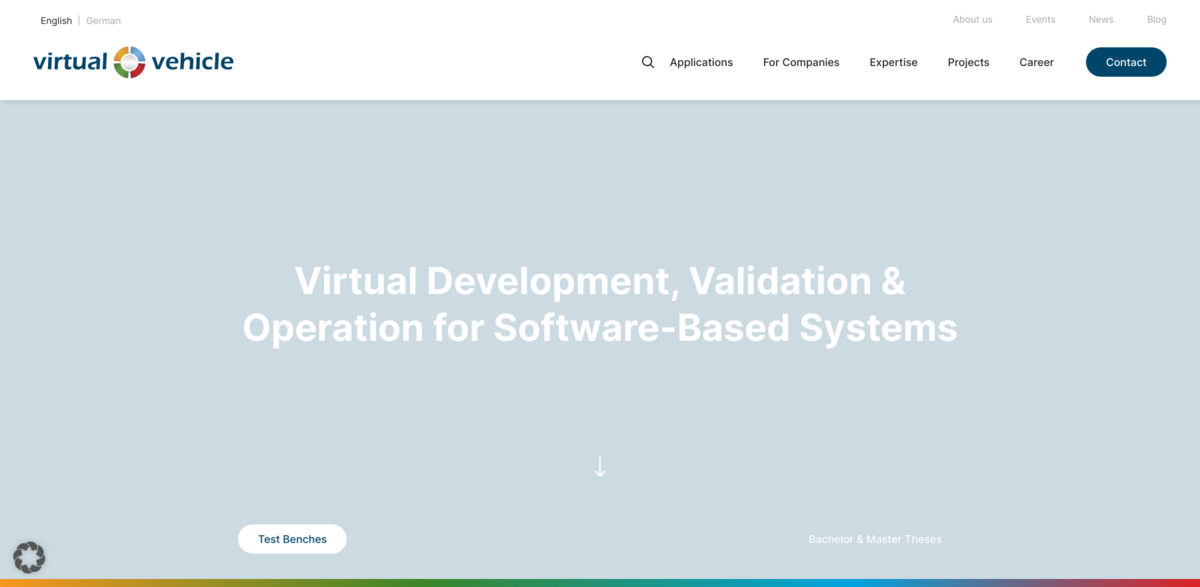What is VIRTUAL VEHICLE?
VIRTUAL VEHICLE is Europe’s largest research center dedicated to virtual vehicle development. It’s all about innovation and strong partnerships with industry players. With around 300 experts on board, the center tackles technological challenges every single day—practical, cross-industry, and always with a sharp focus on real-world applications. Whether it’s automotive, rail, energy, health tech, maritime, or defense, the goal remains the same: making products smarter, safer, and more sustainable. By leveraging simulation, artificial intelligence, digital twins, and model-based development, VIRTUAL VEHICLE helps bring innovations to market faster, safer, and more efficiently. Together, they’re shaping the mobility and technology of tomorrow.
Main Benefits and Key Figures
VIRTUAL VEHICLE stands out not just for its expertise but also for its impressive track record. Here are some key figures that highlight its impact:
- 150+ On-Going Publicly-Funded R&D Projects
- 80+ On-Going Contract Research Projects
- 85+ Annual Publications
Core Research Focus
The center’s research is anchored in several key elements. First, sustainable mobility is a top priority, with a strong emphasis on credible simulation, validation, and operation of complex, networked, software-defined systems—what they call “Green Digital Mobility.” Then there’s vertical integration, which means linking software-based systems with electronic-based systems right down to the chip level. And finally, the effectiveness of research is crucial: innovations from research are implemented directly at company partners, speeding up product development. This approach ensures that research doesn’t just stay on paper but makes a real-world difference.
Mission: Bridging Science and Industry
At its core, VIRTUAL VEHICLE is all about connecting science with industry. The focus areas include credible simulation of complex systems for virtual homologation, efficient data exploration for dynamic digital twins, and human-centered aspects to boost social acceptance. Plus, it acts as a hub for Austrian SMEs working on software-defined system solutions. What really characterizes the center is its application-oriented specialist knowledge combined with strong implementation capabilities. Managing large projects successfully and transferring knowledge across sectors like automotive and rail are also key strengths.
Funding and Support
VIRTUAL VEHICLE Research GmbH is supported by a robust funding framework. It’s part of the COMET K2 Competence Centers for Excellent Technologies, backed by the Austrian Federal Ministry for Innovation, Mobility and Infrastructure (BMIMI), the Austrian Federal Ministry for Economy, Energy and Tourism (BMWET), the Province of Styria, and the Styrian Business Promotion Agency (SFG). The Austrian Research Promotion Agency (FFG) oversees program management. This strong financial and institutional backing ensures the center can push the boundaries of virtual vehicle development.
Project Impact on Sustainable Development Goals (SDGs)
- SDG 9: Industry, Innovation, and Infrastructure – Driving innovation in vehicle development and software systems.
- SDG 11: Sustainable Cities and Communities – Promoting smarter, safer, and more sustainable mobility solutions.
- SDG 12: Responsible Consumption and Production – Enhancing product development efficiency and sustainability.
- SDG 13: Climate Action – Supporting green digital mobility through credible simulation and validation.
Innovative Approach to Virtual Vehicle Development
What makes VIRTUAL VEHICLE truly stand out is its unique approach to combining numerical simulations with hardware testing. This powerful HW-SW system design links virtual and physical testing environments, accelerating development cycles and improving product reliability. The center’s work spans multiple industries, but the common thread is always innovation and practical application. By focusing on software-based systems in automotive and rail, VIRTUAL VEHICLE is not just imagining the future of mobility—it’s actively building it.





















